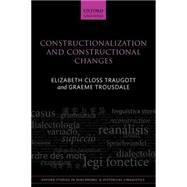- ISBN: 9780198783541 | 019878354X
- Cover: Paperback
- Copyright: 9/14/2016
In this book Elizabeth Closs Traugott and Graeme Trousdale develop an approach to language change based on construction grammar. Construction grammar is a theory of signs construed at the level of the phrase, clause, and complex sentence. Until now it has been mainly synchronic. The authors use it to reconceptualize grammaticalization (the process by which verbs like 'to have' lose semantic content and gain grammatical functions, or word order is reorganised as syntax-prominent rather than discourse-prominent), and lexicalization (in which idioms become fixed and complex words simplified). Basing their argument on the notions that language is made up of language-specific form-meaning pairings and that there is a gradient between lexical and grammatical constructions, Professor Traugott and Dr Trousdale suggest that language change proceeds by micro-steps that involve closely related changes in syntax, morphology, phonology, semantics, pragmatics, and discourse functions. They illustrate their exposition with numerous English examples drawn from Anglo-Saxon times to the present, many of which they discuss in depth.
The book is organized in six chapters. The first outlines the approach and the questions to be addressed, while the second reviews usage-based models of language change, and the third considers the relation between grammatical constructionalization and grammaticalization. Chapters 4 and 5 focus respectively on lexical constructionalization and the role of context, before the final chapter draws the authors' arguments together and outlines prospects for further research. Constructionalization and Constructional Changes propounds and demonstrates a new and productive approach to historical linguistics.
The book is organized in six chapters. The first outlines the approach and the questions to be addressed, while the second reviews usage-based models of language change, and the third considers the relation between grammatical constructionalization and grammaticalization. Chapters 4 and 5 focus respectively on lexical constructionalization and the role of context, before the final chapter draws the authors' arguments together and outlines prospects for further research. Constructionalization and Constructional Changes propounds and demonstrates a new and productive approach to historical linguistics.






